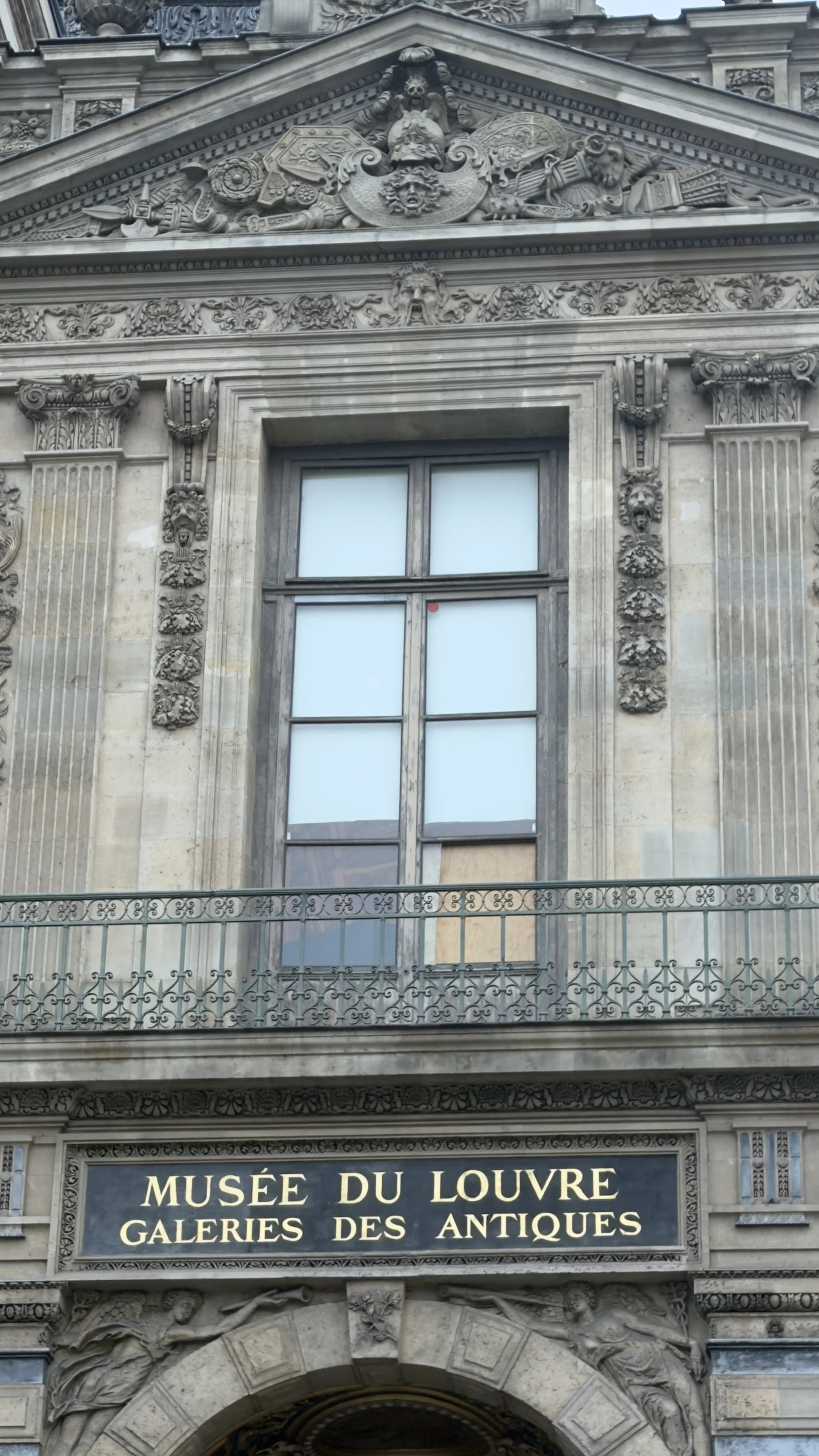On Sunday, October 19, 2025, at 9:37 a.m., the life of the Musée du Louvre was forever altered.
*New details announced this evening added below
Just before 9:30 a.m., while much of Paris still slept, two individuals arrived along the quai François Mitterrand in a nacelle truck, the kind Parisians use to move bulky furniture through upper-story windows. The lift was raised to the corner balcony of the gilded Galerie d'Apollon. Wearing orange and yellow safety vests and carrying a large angle saw, the men climbed over the railing and cut through the lower right pane of glass on the door. In the next three minutes and fifty seconds, the unthinkable happened.
At 9:34 am, the alarm on the door was activated. At 9:35, the room was evacuated of the few tourists in the room, and the alarms in the cases were triggered.
The thieves cut into the cases with their saws, but the glass did not break or crack. Using their heavy tools, they were able to pry the glass apart enough to reach their hand inside and grab the jewelry.
At 9:35 and 33 seconds, the police of the 1st Arrondissement were alerted and on their way. At 9:38 am the thieves had fled through the window.
* New details given just now by the director at the Senate hearing
In the three days since the heist of the century, countless theories, questions, jokes, and AI-generated videos have flooded the internet. What we know so far is that four men were involved in a meticulously planned robbery targeting specific jewels housed in cases closest to the windows. Their operation was precise, as if working from a shopping list.
While two men carried out the theft, two others waited below on high-powered Yamaha TMax scooters, ready for a quick getaway. Police believe the plan was to destroy the truck and set it on fire to eliminate evidence, but the thieves were startled by security and fled, leaving behind multiple items—including one of the stolen jewels.
Many have wondered how such a brazen act could occur unnoticed. Sunday mornings in Paris are blissfully quiet, my favorite time to walk through the city. Before 11 a.m., only a few joggers or dog walkers cross your path. Construction on a Sunday is rare, so that alone might have raised suspicion. Some reports claimed that ongoing work at the Louvre masked the activity, yet renovations to the summer apartments of Anne of Austria had ended more than eighteen months ago. The area beneath the Galerie d'Apollon windows was empty. A woman reportedly called police after seeing the men cut into the window, but the act happened too quickly for intervention.
The thieves used an angle saw rather than smashing the glass—a quieter and faster approach. The same saw sliced open the first two display cases within seconds, allowing the gems to be removed swiftly.
The Galerie d'Apollon underwent a major restoration in 2019, funded by Cartier. The previous display cases, installed in the 1950s, once had a mechanism that would automatically lower the jewels into a safe if the glass was broken. That system had long been out of order. The new cases were of the highest quality—comparable to fine jewelry boutiques—but even they were no match for an industrial saw.
As for alarms, there should have been one on the balcony window and others on the display cases. Some reports claim the window alarm sounded; others, more troubling, suggest it had been deactivated. Culture Minister Rachida Dati publicly denied that claim, insisting the system was operational.
Gallery attendants confronted them but were threatened with saws. Their priority, as always, was visitor safety. Security personnel were quickly alerted, and their arrival startled the thieves, prompting their escape.
The incident has raised serious questions about the Louvre's security measures. The Galerie d'Apollon, though magnificent in its 17th-century splendor, sits just above the Seine with two sides of unbarred windows—an aesthetic vulnerability. In an age of sophisticated and highly motivated criminals, such access points have become liabilities.
In those three minutes and fifty seconds, nine pieces were taken while visitors posed for selfies before the Mona Lisa. The museum had opened just minutes earlier, and crowds were streaming past the Winged Victory toward the Salle des États, leaving the rest of the galleries almost empty. Early mornings in the Galerie d'Apollon are peaceful—a solitude I've often enjoyed in my research. It seems the thieves had studied that same rhythm.
Investigators later recovered several items from the getaway scene, including a helmet, glove, walkie-talkie, blanket, saw, gasoline, and torch—each potentially holding DNA that could lead to arrests.
What will become of the jewels remains uncertain. They are too famous to sell intact. History offers a chilling precedent: in 1785, the Affair of the Diamond Necklace—one of the final scandals that doomed Marie Antoinette—saw a necklace of 685 diamonds dismantled and sold piece by piece across Europe. We can only hope these treasures find their way to a collector who preserves them until they can be recovered.
The Galerie d'Apollon houses what are often called the “Crown Jewels” of France, a collection begun by François I in 1525. Nothing from his reign survives, and the oldest piece today is an eagle brooch dating to 1640. In 1887, over 7,700 jewels were auctioned off in a week-long sale, with proceeds going to the State. Over time, a few historic pieces resurfaced and rejoined the Louvre collection—most within the last forty years.
The eight stolen items once belonged to two queens and two empresses. Among them were the sapphire necklace, earrings, and tiara of Hortense de Beauharnais, daughter of Joséphine and mother of Napoleon III, later purchased by Queen Marie-Amélie, wife of Louis-Philippe.
The magnificent emerald necklace and earrings given by Napoleon Bonaparte to his second wife, Marie-Louise, were also taken. From the first case, the thieves seized pieces once owned by Empress Eugénie de Montijo—her large corsage bow brooch, pearl and diamond tiara, and reliquary brooch.
The only stroke of good fortune was that the Imperial crown of Empress Eugénie was dropped and left behind, a piece with a remarkable story I'll share next week.
** Just now, the director informed us that because of the limited slit in the glass to remove the items, the crown of Eugénie was crushed and then dropped during the escape. It was returned to the museum on Tuesday by the investigators and will be restored.
As I write, Louvre Director Laurence des Cars is addressing the French Senate about the theft, the investigation, and future security measures. I'll continue to update through Instagram, Facebook, and the podcast as more unfolds.
Listen to this week's new podcast episode for our immediate coverage of the theft and everything we knew in those first hours.





